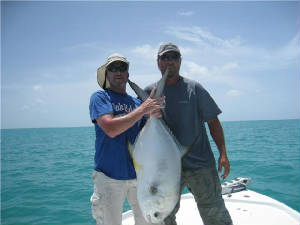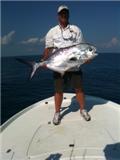SPRING TIME, PERMIT ARE ALSO EVERYWHERE
Permit reach a maximum length of at least 48 inches (122 cm) and a weight of 79 pounds (36 kg). They grow rapidly
until an age of 5 years, at which point growth slows considerably. Permit reach sexual maturity at about 2.3 years for males,
and 3.1 years for females. Their size at sexual maturity ranges from 19.1 inches (486 mm) for males and 21.5 inches (547 mm)
for females. Permit can attain an age of 23 years, though they probably live longer. Other carangids, such as the Florida
pompano (Trachinotus carolinus) and the white trevally (Pseudocaranx dentex), are known to reach ages of
7 and 49 years, respectively. | |
The species is most abundant in southern
Florida. Permit primarily occupy
inshore regions such as flats and sandy beaches, and deeper cuts, channels, and holes adjacent to these areas. Permit primarily forage on flats and intertidal areas, entering shallow water on incoming
tides from deeper adjacent channels and basins. They usually travel in schools of about ten, but may school in larger numbers;
larger permit tend to be more solitary, feeding alone or in pairs. Permit also congregate around wrecks and other deeper-water
structures.
Like the bonefish, the permit uses its hard mouth to dig into the
benthos and root up its prey. These food items usually consist of crustaceans and mollusks, which the permit crushes with
its granular teeth and pharyngeal bony plates. However, as opportunistic feeders, permit will eat a variety of animals, including
amphipods, copepods, mollusks, polychaetes, fish and insects. Developmentally, permit exhibit planktivorous feeding habits
as juveniles, eating copepods, amphipods, mysids, larval shrimp, and fish. As they increase in size, permit begin to feed
on benthic prey including mole crabs, coquin clams, flatworms, gastropods, and sessile barnacles. Larger adults feed on gastropods,
sea urchins, bivalves, and crabs. | |
In deeper waters
up to 30 m, permit often congregate around structures such as reefs, jetties, and wrecks where they frequently occur in large
schools Permit spawning may last
all year, but occurs primarily from May through June in the Florida Keys. Spawning peaks during these summer months, with
extended spawning seasons occurring outside this main period and a decrease in spawning activity during the winter months.
Researchers have found that permit may spawn over natural and artificial reefs or in nearshore waters in the middle and lower
Florida Keys. Males reach sexual maturity earlier than females, 2.3 versus 3.1 years, and at respective sizes of 19.1 inches
(486 mm) and 21.5 inches (547 mm).

